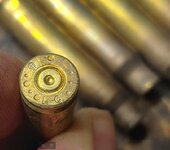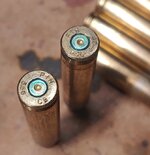Navigation
Install the NWFA app
How to install the app on iOS
Follow along with the video below to see how to install our site as a web app on your home screen.
Note: This feature may not be available in some browsers.
More Options
You are using an outdated browser
The browser you are using is likely incompatible with our website. We recommend upgrading your current browser or installing an alternative.
JavaScript is disabled
Our website requires JavaScript to function properly. For a better experience, please enable JavaScript in your browser settings before proceeding.
-
Join the #1 community for gun owners of the Northwest
We believe the 2nd Amendment is best defended through grass-roots organization, education, and advocacy centered around individual gun owners. It is our mission to encourage, organize, and support these efforts throughout Oregon, Washington, Idaho, Montana, and Wyoming.Free Membership Benefits
- Fewer banner ads
- Buy, sell, and trade in our classified section
- Discuss firearms and all aspects of firearm ownership
- Join others in organizing against anti-gun legislation
- Find nearby gun shops, ranges, training, and other resources
- Discover free outdoor shooting areas
- Stay up to date on firearm-related events
- Share photos and video with other members
- ...and much more!
Bronze Supporter
- Messages
- 37,277
- Reactions
- 128,609
Yes, but the "conventional wisdom" is MILSPEC 5.56 brass has a bit more wall thickness than .223 and therefore a bit less powder capacity than .223 which could potentially cause higher pressures if you load max-load .223 recipes in MILSPEC 5.56 cases.
The "big" differences are in the barrel chamberings.
- Thread Starter
- #3
I dont plan on that. If I use the 556 brass I would work up its own ladder test starting at the bottom of the load data for 556. But this is a good point to point out.Yes, but the "conventional wisdom" is MILSPEC 5.56 brass has a bit more wall thickness than .223 and therefore a bit less powder capacity than .223 which could potentially cause higher pressures if you load max-load .223 recipes in MILSPEC 5.56 cases.
Bronze Supporter
- Messages
- 37,277
- Reactions
- 128,609
Like I added in my prior post after you quoted it… the .223 and 5.56 barrel chambers are the critical difference.I dont plan on that. If I use the 556 brass I would work up its own ladder test starting at the bottom of the load data for 556. But this is a good point to point out.
Bronze Supporter
- Messages
- 37,277
- Reactions
- 128,609
That's Lake City circa 2019, NATO spec.Can anyone tell me who makes this brass? I saved it from a while ago but cant recall who made it...
View attachment 1170985
- Thread Starter
- #7
ah... yes....Like I added in my prior post after you quoted it… the .223 and 5.56 barrel chambers are the critical difference.
Im aware of a chamber difference... something to do with higher pressures in 556 I think. You can shoot 223 in a 556 but not the other way around (and people will argue that but I wont...)
My chamber is 223 Wylde I should be GTG.
Bronze Supporter
- Messages
- 37,277
- Reactions
- 128,609
No, it has to do with a longer lead to the rifling grooves in 5.56 chambers… that's why you can run .223 in a 5.56 chamber without the bullet's ogive getting jammed into the grooves.ah... yes....
Im aware of a chamber difference... something to do with higher pressures in 556 I think. You can shoot 223 in a 556 but not the other way around (and people will argue that but I wont...)
My chamber is 223 Wylde I should be GTG.
- Thread Starter
- #9
those damn grooves always gettin in the way...No, it has to do with a longer lead to the rifling grooves in 5.56 chambers… that's why you can run .223 in a 5.56 chamber without the bullet's ogive getting jammed into the grooves.
I knew it had a longer lead but always thought that was part of the chamber, I learned something new.
Silver Vendor
- Messages
- 2,890
- Reactions
- 7,943
It has to do with pressure.
I load both 223 and 5.56 cases to just below high 223 velocity/pressure and can use in either chamber...no problems.
5 56 velocity runs around 3,300, and I load at around 2,800+
Most people won't notice a poi change out to 200 yards.
With Ramshot TAC, you can load close to 5.56 velocity, while still staying in 223 pressure
I load both 223 and 5.56 cases to just below high 223 velocity/pressure and can use in either chamber...no problems.
5 56 velocity runs around 3,300, and I load at around 2,800+
Most people won't notice a poi change out to 200 yards.
With Ramshot TAC, you can load close to 5.56 velocity, while still staying in 223 pressure
- Messages
- 2,632
- Reactions
- 4,003
.223 and 5.56 cases have identical external dimensions. While it's commonly stated that military brass has thicker walls and hence less capacity. The difference between internal capacity within production lots of the same ammo vary as much or more as that between military and commercial. So, some military cases have less capacity than some commercial cases.
The 5.56 chamber has a slightly larger neck diameter and longer leade to allow tracer ammo to be fired without creating an overpressure situation. To make up for the lower velocity that the larger chamber created, the load was increased to bring it back to the velocity specs.
So, a 5.56 round in a 5.56 chamber creates the same overall chamber pressure as a .223 round in a .223 chamber.
The 5.56 chamber has a slightly larger neck diameter and longer leade to allow tracer ammo to be fired without creating an overpressure situation. To make up for the lower velocity that the larger chamber created, the load was increased to bring it back to the velocity specs.
So, a 5.56 round in a 5.56 chamber creates the same overall chamber pressure as a .223 round in a .223 chamber.
- Thread Starter
- #13
Im probably just going to stick with 223 brass for what I need, but this is why im curious about using 556 brass... because when I buy bulk range ammo to practice with I often get deals on 556 and will end up with a ton of 556 brass. The thought occurred to me to just download the powder charge enough to use any brass.I load both 223 and 5.56 cases to just below high 223 velocity/pressure and can use in either chamber...no problems.
5 56 velocity runs around 3,300, and I load at around 2,800+
Most people won't notice a poi change out to 200 yards.
Silver Vendor
- Messages
- 2,890
- Reactions
- 7,943
Being in the commercial loading biz, we have to cater to the lowest quality rifle chamber they may be used...so lowering the pressure to assure that they are safe to shoot, no matter the chamber, while also maintaining minimum poi shift out to 200 yards can be tough...but we managed to do it.
Here's to your happy loading journey!
Here's to your happy loading journey!
- Thread Starter
- #15
My reloading needs here are totally different as Im not a high volume reloader. For practice and range use Id just buy a brick of 556 or 223 whatevers cheapest. But as Ive sorted the different brass Ive shot by mfg to reload I cant help but think of a universal handload, which is why I asked if the 556 brass would fit in my 223 dies. As I learn more and go down the loading journey its not a bad idea to keep in mind to have a load recipe that works in any brass.Being in the commercial loading biz, we have to cater to the lowest quality rifle chamber they may be used...so lowering the pressure to assure that they are safe to shoot, no matter the chamber, while also maintaining minimum poi shift out to 200 yards can be tough...but we managed to do it.
Here's to your happy loading journey!
Same dies for .223 and 5.56
I did some volume testing awhile back and most cases have very close to the same internal volume, commercial and military. I tested several different military brands of brass and several different commercial brands. All were close enough that I decided to not worry about it.
The one exception was Remington .223 brass. It had a considerable amount more volume than all the rest.
I did some volume testing awhile back and most cases have very close to the same internal volume, commercial and military. I tested several different military brands of brass and several different commercial brands. All were close enough that I decided to not worry about it.
The one exception was Remington .223 brass. It had a considerable amount more volume than all the rest.
Silver Vendor
- Messages
- 2,890
- Reactions
- 7,943
Actually high volume vs handloader requires the same attention to detail and load development.My reloading needs here are totally different as Im not a high volume reloader. For practice and range use Id just buy a brick of 556 or 223 whatevers cheapest. But as Ive sorted the different brass Ive shot by mfg to reload I cant help but think of a universal handload, which is why I asked if the 556 brass would fit in my 223 dies. As I learn more and go down the loading journey its not a bad idea to keep in mind to have a load recipe that works in any brass.
I don't wish you luck...I wish you much patience and success.
- Thread Starter
- #18
This is good to know. Right now I have like almost no experience with this outside of my first ladder test and then last weekend I ran 20 rds to check the charge I picked. Im starting with some new (virgin) Nosler 223 brass but I also loaded 5rds with some Federal 223 brass testing side by side on the same charge and the results were nearly identical. I got a 1/4" smaller group with the Federal brass is all. The POI was the same. Next Im going to load 20rds of each brass to compare, I might add 5rds of some once fired Winchester brass I saved to check as well. Ideally it would be awesome to not worry about sorting brass but not a deal breaker.I did some volume testing awhile back and most cases have very close to the same internal volume, commercial and military. I tested several different military brands of brass and several different commercial brands. All were close enough that I decided to not worry about it.
To be clear, If going for the best accuracy I do sort by headstamp and # of times fired.
Acceptable accuracy means different things to different people and will often require different degrees of attention to detail and processing of the brass.
Acceptable accuracy means different things to different people and will often require different degrees of attention to detail and processing of the brass.
Share This Discussion
Similar threads
Upcoming Events
New Classified Ads
-
-
-
-
-
-
-
Ruger 10/22 - 60th Anniversary (Brand New) Limited Edition
- Started by tenthousand
- Replies: 0
-
-
-
Support Our Community
If our Supporting Vendors don't have what you're looking for, use these links before making a purchase and we will receive a small percentage of the sale














